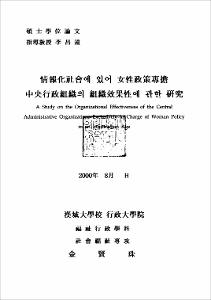情報化社會에 있어 女性政策專澹 中央行政組織의 組織效果性에 관한 硏究
- Files in This Item:
-
-
Download
 000000066071.pdf
기타 데이터 / 3.81 MB / Adobe PDF
000000066071.pdf
기타 데이터 / 3.81 MB / Adobe PDF
-
Items in Repository are protected by copyright, with all rights reserved, unless otherwise indicated.
 000000066071.pdf
기타 데이터 / 3.81 MB / Adobe PDF
000000066071.pdf
기타 데이터 / 3.81 MB / Adobe PDFItems in Repository are protected by copyright, with all rights reserved, unless otherwise indicated.